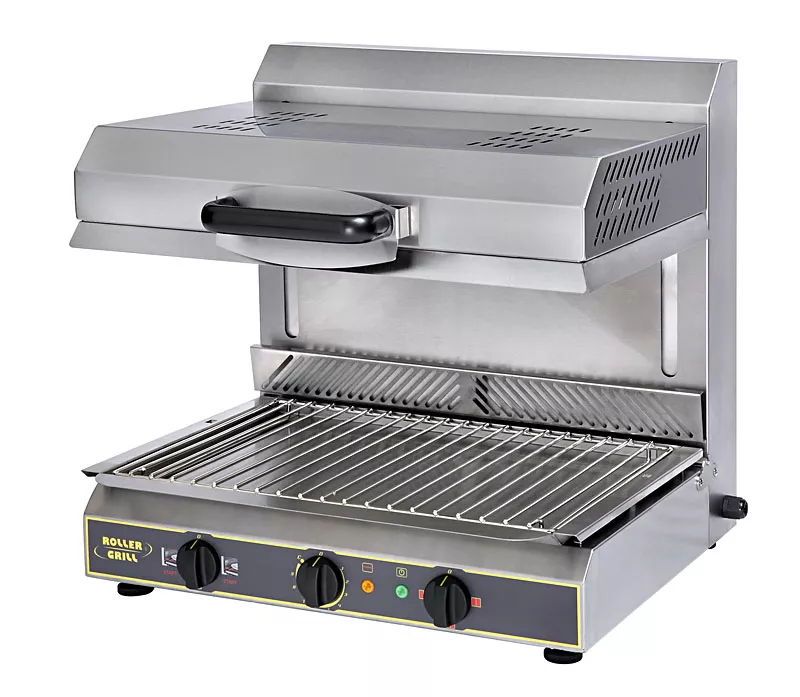Salamander grills are a versatile and high-performance kitchen appliance widely used in commercial kitchens and even in upscale home cooking environments. Known for their intense heat output and precise cooking control, salamander grills are indispensable for broiling, toasting, finishing, and caramelizing a wide variety of dishes. These powerful cooking devices, often called salamanders, offer distinctive cooking capabilities that make them stand out from traditional ovens and grills. In this article, we will explore in-depth the different aspects of salamander grills, their uses, types, features, and advantages.
What Exactly Is a Salamander Grill?
A salamander grill is a type of broiler used primarily in commercial kitchens. Its compact size and powerful heat source make it ideal for high-heat cooking applications, especially those requiring rapid and intense browning, crisping, or melting. Unlike conventional ovens, salamander grills feature a top-down heating element, allowing chefs to control temperature precision and deliver exceptional cooking results.
Typically, salamander grills reach extremely high temperatures—often upwards of 1,500°F (815°C)—in a very short period of time. This makes them suitable for finishing dishes such as gratin, toast, cheese melting, and browning meats like steaks or chops. Salamander grills are designed to be mounted on a wall or placed atop a countertop for easy access in busy kitchens.
Key Features of Salamander Grills
- High Temperature Control: Salamander grills are equipped with powerful heating elements that allow for intense and focused heat. This feature is crucial when you need to cook food quickly or finish a dish by adding a crisp layer of texture.
- Adjustable Cooking Racks: The adjustable rack system allows chefs to move the food closer or farther from the heat source, giving greater control over the cooking process. This is especially important for preventing overcooking or burning delicate foods.
- Energy Efficiency: Due to their fast heating time, salamander grills consume less energy than traditional ovens. They are often used for short bursts of cooking, such as melting cheese or searing proteins, which contributes to their energy-efficient operation.
- Compact Design: Salamander grills are compact and designed to be used in smaller kitchen spaces. Their efficient design maximizes heat distribution while minimizing the footprint they take up in the kitchen, making them ideal for busy commercial kitchens.
- Versatile Cooking Applications: From broiling meats to melting cheese for pizzas or gratins, salamander grills provide versatility in cooking. The intense radiant heat ensures quick and even cooking, making them perfect for finishing dishes.

Types of Salamander Grills
Salamander grills come in several variations depending on their fuel source, size, and application. Let's look at the primary types of salamander grills available:
1. Gas-Powered Salamander Grills
Gas salamander grills use natural gas or propane to power their heating element. These types are popular in commercial kitchens because they provide consistent high heat and immediate temperature control. Many chefs prefer gas-powered salamanders for their reliable and responsive performance. Gas grills are also known for their durability and cost efficiency when it comes to operating large kitchens that cook at high volumes.
2. Electric Salamander Grills
Electric salamander grills use electricity as their primary heat source. They are easier to install in spaces where gas lines may not be available. Electric salamander grills offer precision control over temperature settings and are generally more compact in design. Additionally, they produce less ambient heat, which can be advantageous in small or climate-controlled kitchens. However, they may take a little longer to reach the desired cooking temperature compared to gas models.
3. Wall-Mounted Salamander Grills
These grills are installed on the walls of commercial kitchens to save counter space. Wall-mounted salamanders are commonly found in professional kitchens that need fast, easy access to broiling and finishing capabilities without taking up valuable workspace. Their installation height ensures that the chef can keep an eye on the dish being cooked without bending or stretching.
4. Countertop Salamander Grills
For smaller kitchens or more compact operations, countertop salamander grills provide the same powerful broiling capabilities in a portable and space-saving format. These grills can be set up on any kitchen surface and often feature adjustable legs to customize the height of the grill for optimal use.

What Are Salamander Grills Used For?
Salamander grills are used for a variety of cooking techniques that require fast, high-heat exposure. The intense radiant heat makes them particularly useful for browning, caramelizing, and melting ingredients. Here are some common uses:
- Broiling Meat: A salamander grill can broil steaks, chops, and other proteins in a matter of minutes, giving them a delicious sear and locking in the juices while cooking the inside to perfection.
- Toasting Bread: Salamander grills are perfect for toasting breads, buns, and rolls quickly. Restaurants often use them to toast bread for sandwiches, burgers, or to add a crispy finish to garlic bread.
- Cheese Melting: From pizzas to French onion soup or au gratin dishes, the salamander grill excels at melting cheese evenly, providing a rich, golden-brown topping.
- Finishing Dishes: Many chefs use salamander grills to finish dishes that have been cooked through by other means. For example, a steak may be pan-seared and then finished under the salamander to achieve a perfect crust without overcooking the inside.
- Caramelizing and Crisping: Certain foods benefit from the intense radiant heat that a salamander provides. Crème brûlée can be caramelized perfectly, and foods like vegetables or fish can gain a crispy outer texture while remaining tender inside.
Advantages of Using a Salamander Grill
- Speed: Salamander grills cook foods incredibly fast, making them ideal for kitchens where efficiency is paramount. Their quick heat-up time and high-temperature cooking reduce the overall cook time for many dishes.
- Precision: Unlike traditional ovens, salamander grills give chefs precise control over browning and melting. The ability to adjust cooking racks and heat levels allows for fine-tuning cooking results.
- Space-Saving: Whether mounted on the wall or placed on a countertop, salamander grills take up much less space than conventional ovens, making them perfect for kitchens with limited room.
- Multi-Functionality: Salamander grills are versatile tools capable of grilling, broiling, finishing, and toasting. Their ability to quickly adapt to various cooking techniques makes them a valuable addition to any kitchen.
- Energy Efficiency: Due to their high heat concentration and speed, salamander grills use less energy than larger, slower-heating appliances, making them an eco-friendly choice for restaurants and home kitchens alike.
Conclusion: The Essential Role of Salamander Grills in Modern Kitchens
In summary, salamander grills are a must-have piece of equipment for any kitchen that values efficiency, versatility, and precision. Whether it's a busy commercial restaurant or a gourmet home setup, the salamander grill provides unmatched broiling, browning, and toasting capabilities. Their ability to generate intense heat rapidly makes them indispensable for finishing dishes to perfection. From professional chefs to home cooks, anyone can benefit from the fast cooking times, adjustable heat, and compact design that these powerful grills offer. In a world where kitchen space and cooking time are often at a premium, salamander grills deliver the high-performance results that today’s kitchens demand.
Enter your text here...
